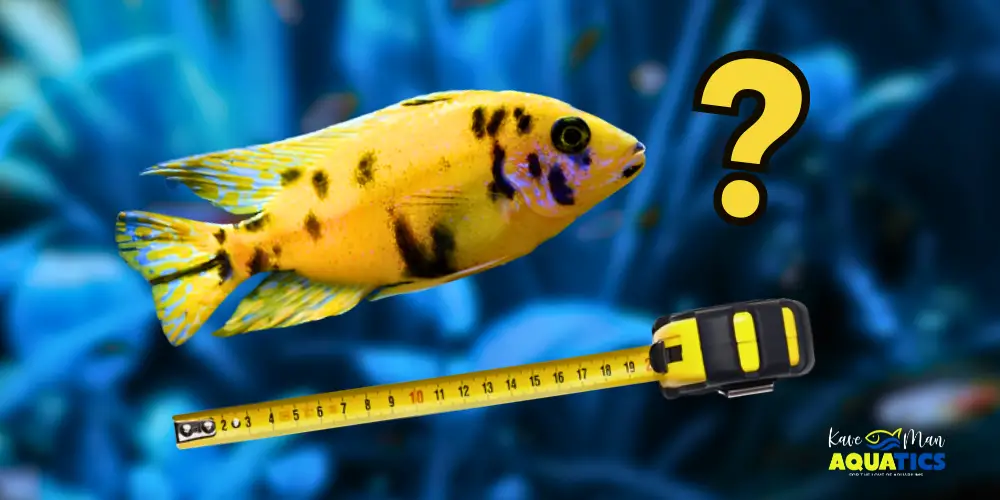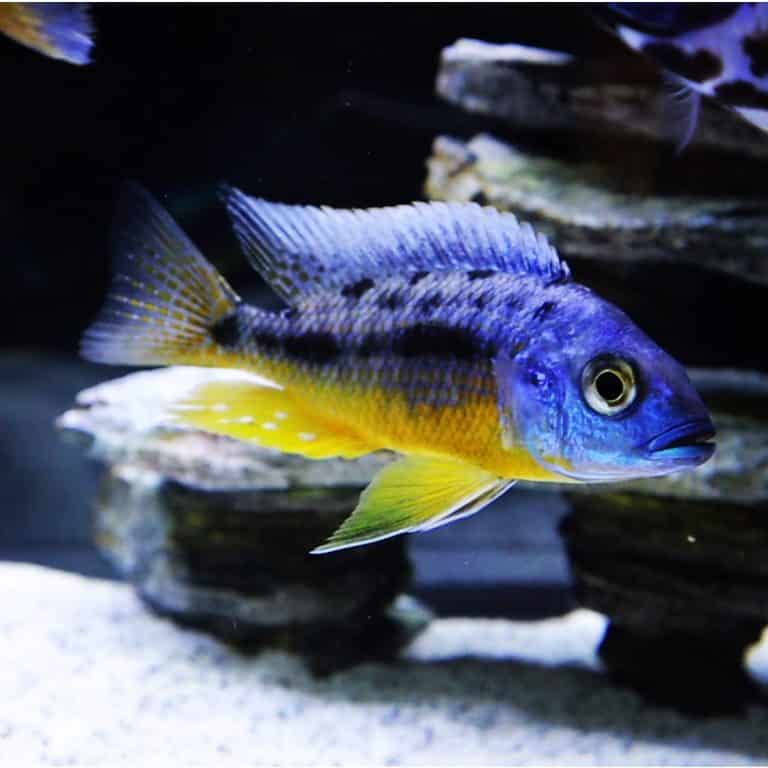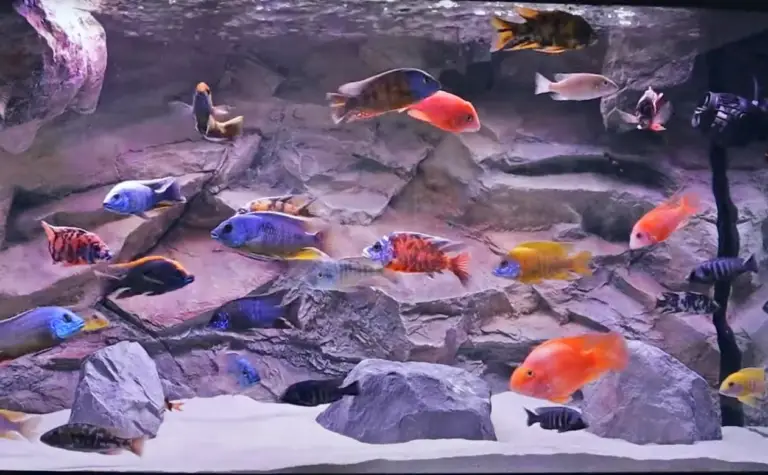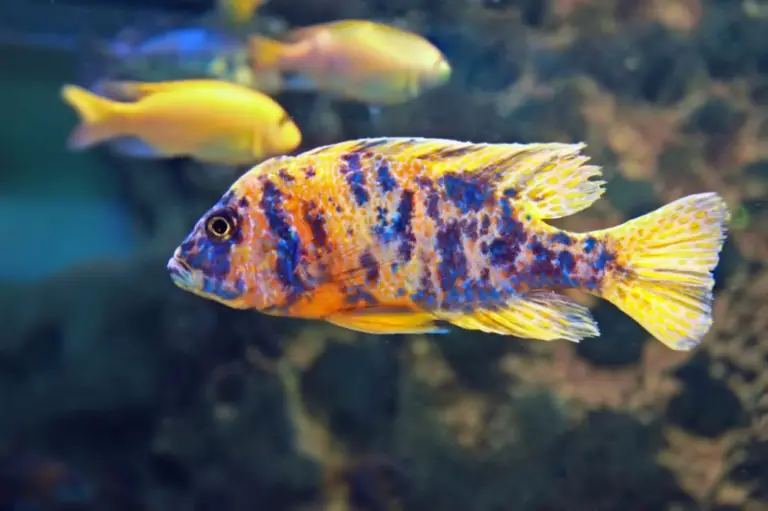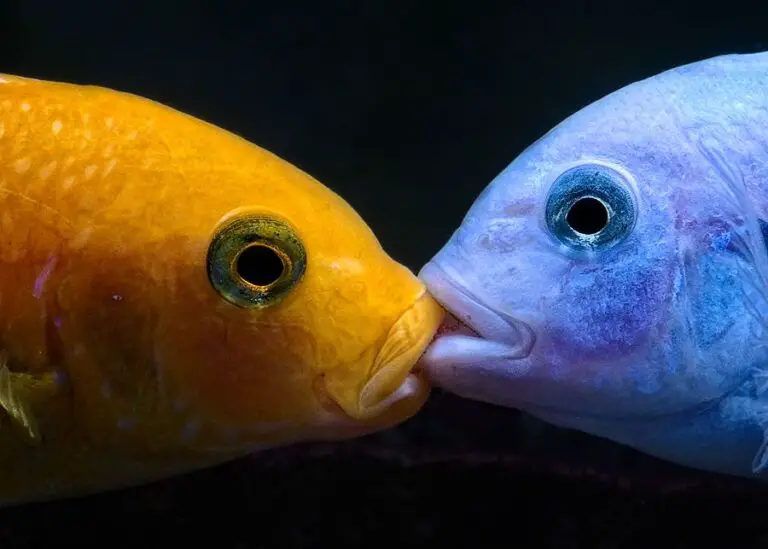How Big Do African Cichlids Get?
African cichlids are a vibrant and diverse group of freshwater fish native to Africa’s great lakes. Known for their stunning colors and complex behaviors, they are a favorite among aquarium enthusiasts for a reason!
But, if you’re new to these majestic species, you might be wondering — “How big do African cichlids get?” It’s an important question to ask because you need to be prepared with the right African cichlid aquarium setup.
So, without further ado, here’s more information about African cichlid growth.
7 Factors Affecting the Size of African Cichlids
So, how big do African cichlids get? It depends… Yeah, unfortunately, there’s no straightforward answer, BUT, there are a few factors that affect African cichlid growth.
1. Species
First things first, African cichlids come in all shapes and sizes, and the species you choose has a big say in how large they will grow. Take Mbuna cichlids as an example — they stay on the smaller side, around 4-6 inches. But when we look at Peacock cichlids and Haps, well, they can easily hit the 8-12 inch mark.
2. Genetics
Just like us humans, genetics play a huge role in how big your cichlid will get. Even with the same species, some fish are just genetically destined to grow bigger. It is what it is — it’s just something you don’t have much control over, but it’s worth keeping in mind.
3. Diet
Are your cichlids eating good? Well… A well-balanced diet packed with the right nutrients will help them grow to their full potential. Think of it like this: if your cichlid eats a variety of high-quality foods — like protein-rich pellets, vegetables, and occasional frozen or live treats — they’re more likely to grow big and healthy.
4. Tank Size
Now your African cichlid aquarium setup matters too! A bigger tank gives them more room to swim, and more space equal to more growth. If your tank is too small, it can actually stunt their growth — a big no-no. As a general rule of thumb, the larger the cichlid, the bigger the tank they’ll need.
5. Water Quality
Clean water is key! It’s often the answer to many problems you may encounter during your journey. Poor water conditions can stress your fish, which can slow down their growth or even cause health issues. Regular water changes and keeping an eye on your water parameters will help your cichlid thrive.
Also, note that African cichlids have a large aquarium bioload, which also impacts the frequency of your water changes.
6. Stress Levels
Believe it or not, stress can stunt your African cichlid growth. Stressors like poor water quality, overcrowding, or aggressive tank mates can all negatively impact how big your fish get. Always try to create a peaceful environment.
7. Age
It’s important to remember that cichlids grow throughout their lives, but their growth rate slows down as they age. Younger fish grow more quickly, so if you’ve got a juvenile cichlid, expect them to hit their growth spurts early on.
Average Size by Species
Now, we did say that African cichlid growth and size depends on the species — so, here’s a list of various species’ sizes:
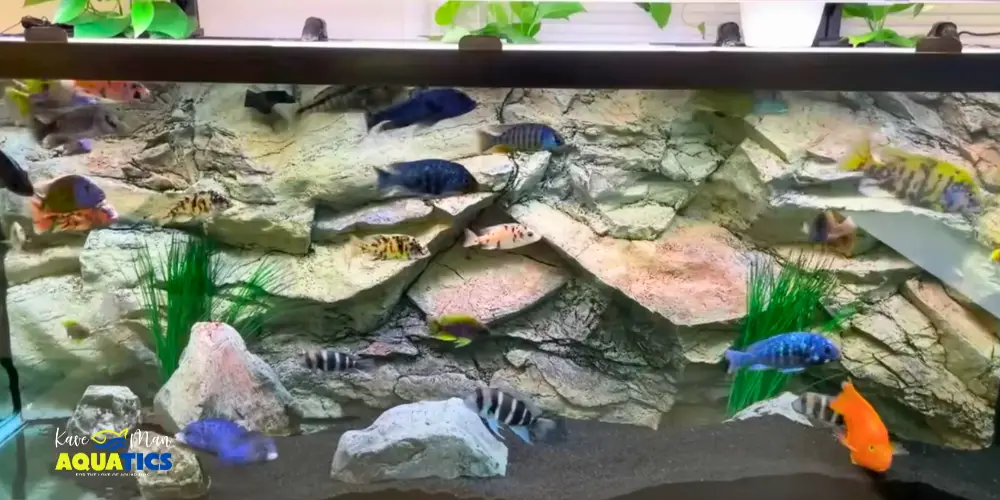
Mbuna Cichlids (Lake Malawi)
- Electric Yellow: 3 to 4 inches (7.5 to 10 cm)
- Red Zebra: 4 to 5 inches (10 to 12.5 cm)
- Demasoni Cichlid: 2.5 to 3 inches (6 to 7.5 cm)
- Auratus Cichlid: 4 to 5 inches (10 to 12.5 cm)
- Cobalt Blue Zebra: 4 to 5 inches (10 to 12.5 cm)
Peacock Cichlids (Aulonocara, Lake Malawi)
- Sunshine Peacock: 4 to 6 inches (10 to 15 cm)
- Blue Peacock: 4 to 6 inches (10 to 15 cm)
- Ruby Red Peacock: 4 to 5 inches (10 to 12.5 cm)
- Dragon Blood Peacock: 4 to 6 inches (10 to 15 cm)
- Red Shoulder Peacock: 4 to 6 inches (10 to 15 cm)
Haplochromis (Haps, Lake Malawi, and Lake Victoria)
- Venustus: 8 to 10 inches (20 to 25 cm)
- Livingstonii: 8 to 10 inches (20 to 25 cm)
- Compressiceps: 6 to 8 inches (15 to 20 cm)
- Electra: 6 to 7 inches (15 to 18 cm)
- Deep Water Hap: 7 to 9 inches (18 to 23 cm)
Tanganyikan Cichlids (Lake Tanganyika)
- Frontosa: 12 to 15 inches (30 to 38 cm)
- Brichardi: 3 to 4 inches (7.5 to 10 cm)
- Julidochromis Marlieri: 4 to 5 inches (10 to 12.5 cm)
- Leleupi: 3 to 4 inches (7.5 to 10 cm)
- Shell Dweller: 1.5 to 2 inches (4 to 5 cm)
Victoria Cichlids (Lake Victoria)
- Flameback: 3 to 4 inches (7.5 to 10 cm)
- Christmas Fulu: 4 to 5 inches (10 to 12.5 cm)
- Thick Skin: 4 to 5 inches (10 to 12.5 cm)
- Rock Kribensis: 4 to 6 inches (10 to 15 cm)
- Ruby Green: 3 to 4 inches (7.5 to 10 cm)
The Growth Stages of African Cichlids
To give you some more info about how big do African cichlids get, let’s quickly discuss their growth stages — from fry to seniors.
1. Fry Stage (Hatching to 1 Month)
After hatching, African cichlid fry are very small, typically only a few millimeters in length. At this stage, they’re pretty vulnerable and depend on their yolk sac for nutrition during the first few days. But don’t let that fool you — they grow quickly! They can reach about 0.5 to 1 inch (1.3 to 2.5 cm) by the end of the first month.
2. Juvenile Stage (1 Month to 6 Months)
As juveniles, cichlids are more active and start to resemble their adult friends. During this stage, juveniles grow to about 2 to 3 inches (5 to 7.5 cm). Growth rates vary depending on species, diet, and environmental conditions.
3. Sub-Adult Stage (6 Months to 1 Year)
In the sub-adult stage, cichlids continue to mature, and their colors become more pronounced. You could say this is their “teenage years.” Sub-adults reach about 3 to 4 inches (7.5 to 10 cm), though larger species might grow even more.
4. Adult Stage (1 Year and Older)
African cichlids are considered adults when they reach sexual maturity, which typically occurs around 1 year of age. Here’s where the true variation comes in by the way. Adults can range in size from 4 to 15 inches (10 to 38 cm) depending on the species. Growth slows down significantly once they reach adulthood.
5. Senior Stage (Varies by Species)
As cichlids age, they enter a senior stage where growth has stopped, and they may experience a decline in activity, coloration, and reproductive capabilities. Lifespan can vary widely by species, ranging from 5 to 10 years or more.
10 Tips to Maximize Your African Cichlid Growth
Okay okay, that may have been a lot of info. But let’s squeeze in this piece of valuable information — a few tips to get the most of your African cichlid growth:
- Feed a balanced diet: Offer a variety of high-quality foods, including pellets, flakes, and live or frozen foods, to ensure they get all the nutrients they need.
- Maintain clean water: Regularly change the water and keep the tank clean to prevent diseases and promote healthy growth.
- Optimize tank size: Your African cichlid aquarium setup can make all the difference. Provide ample space for swimming — larger tanks support better growth and reduce stress.
- Monitor water parameters: Keep the water temperature, pH, and hardness within the ideal range for your species to ensure optimal growth conditions.
- Include hiding spots: Add rocks and decorations to create territories and reduce stress, which can impact growth.
- Ensure proper lighting: Use appropriate lighting to mimic natural conditions and support healthy growth and color.
- Avoid overcrowding: Maintain a suitable number of fish for the tank size to prevent stunted growth and aggression.
- Regular feeding schedule: Feed your cichlids on a consistent schedule and avoid overfeeding to prevent obesity and health issues.
- Provide varied diet: Include vegetable matter, such as spirulina, along with protein sources to meet their dietary needs.
- Watch for illnesses: Monitor for signs of disease and address any health issues promptly to avoid stunted growth.
Get Expert Tips and Resources
Are you ready to take your African cichlid care to the next level? KaveMan Aquatics got you covered with a few handy resources.

If you’ve ever been overwhelmed by the challenges of keeping African cichlids or felt unsure about where to begin, our Keeping African Cichlids book is for you. It simplifies the complexities of cichlid care, covering everything from reducing aggression to maintaining optimal water conditions.
If you prefer a more interactive approach, start with our free webinar. Learn the top 3 crucial aspects of cichlid care, including creating the perfect environment and nutrition strategies. It’s a great way to get a taste of what you can achieve before diving into a full course.
See you on the other side!
-
How Big Do African Cichlids Get?
African cichlids are a vibrant and diverse group of freshwater…

